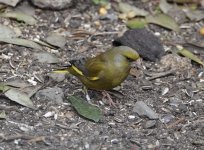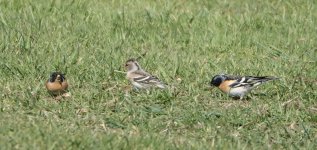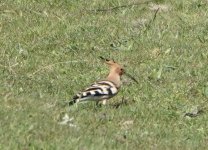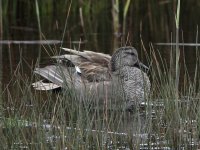chowchilla
Well-known member
I may regret this...
As the last embers of January died, I found myself on Tresco, having been deposited there by a helicopter that was meant to be flying to St Marys. I headed down an unmade track, hoping I was going in the right direction.
Tresco was certainly a little odd. Much of the plant life was barely recognisable; a miscellany of strange plants from far away lands grew amongst the natives, and sometimes dominated them. I had heard many a tale of the unique nature of these islands, and already a sense of having stepped through the Looking Glass to a slightly tilted version of Old England, had taken hold. But there was the familiar here too... birds I recognised, and so I gradually compiled a mental list of them as I wrestled with heavy luggage on the uneven track. House Sparrow, Woodpigeon, Collared Dove... Herring Gull, Carrion Crows aplenty. Nothing that would even turn heads in British birding circles. To me however, these seemed a little exotic for a few minutes at least. I was used to seeing Honeyeaters, Sunbirds and Lorikeets. But in truth, they were old familiar names to birds I had grown up with, and they were a reassuring part of the tapestry of the islands- anchors in the oddness of much of the plant life.
Much of Scilly's birdlife is a modest selection of familiar UK land birds and coastal birds. Chaffinches, Greenfinches and Goldfinches are common- Wrens and Dunnocks even moreso. Song Thrushes, unusually, outnumber the Blackbirds; something I find strangely reassuring. The islands are more surprising in terms of what is absent. A Magpie would cause a bit of a stir, as would Long-tailed Tits or a Great-spotted Woodpecker. And as you'll see later, other common British birds can cause a mini-twitch of the local birders. Scilly is, of course, more famous in birding circles for national rarities hailing from further flung places. It being January, I had to contend myself with the local birds for now. But then, I did have the not insurmountable task of working out where the hell I was meant to be going, even as I noted my first Great Tits, Mallards and Pheasants. Half an hour later, I was 'found' and brought back to the heliport by the transport that was supposed to have taken me to the ferry. I shan't elaborate too much on what went wrong here, but suffice it to say, that a certain driver had been a little impatient earlier, and in the time it had taken me to use the toilet at the terminal, had left without me. Two women had similarly been stranded. OK, so I did elaborate a bit... but then what was the rush? I looked about at the complete and utter lack of traffic and concluded that there was no need ro rush at all. This isn't London. Far from it... Scilly moves at a different pace, and to a different beat.
The ferry to St Marys yielded my first Great Black-backed Gulls, Oystercatcher and Little Egret. By now, having dragged heavy luggage halfway across Tresco, I was flagging. My brain literally began to shut down. I was ready for sleep. As a result, the trip across the island to my accommodation dissoved into a blur of indistinct memory. Jetlag had barely left my system, and then had one last hurrah.
I had relocated myself in my later middle age to a new country, or rather an old one; one that I had lived in fifteen years earlier. I've been told I'm mad many times since... But so far at least, I would argue that Scilly, the place I now call home, is just a little bit special. Even when the birding isn't exactly stellar.
As the last embers of January died, I found myself on Tresco, having been deposited there by a helicopter that was meant to be flying to St Marys. I headed down an unmade track, hoping I was going in the right direction.
Tresco was certainly a little odd. Much of the plant life was barely recognisable; a miscellany of strange plants from far away lands grew amongst the natives, and sometimes dominated them. I had heard many a tale of the unique nature of these islands, and already a sense of having stepped through the Looking Glass to a slightly tilted version of Old England, had taken hold. But there was the familiar here too... birds I recognised, and so I gradually compiled a mental list of them as I wrestled with heavy luggage on the uneven track. House Sparrow, Woodpigeon, Collared Dove... Herring Gull, Carrion Crows aplenty. Nothing that would even turn heads in British birding circles. To me however, these seemed a little exotic for a few minutes at least. I was used to seeing Honeyeaters, Sunbirds and Lorikeets. But in truth, they were old familiar names to birds I had grown up with, and they were a reassuring part of the tapestry of the islands- anchors in the oddness of much of the plant life.
Much of Scilly's birdlife is a modest selection of familiar UK land birds and coastal birds. Chaffinches, Greenfinches and Goldfinches are common- Wrens and Dunnocks even moreso. Song Thrushes, unusually, outnumber the Blackbirds; something I find strangely reassuring. The islands are more surprising in terms of what is absent. A Magpie would cause a bit of a stir, as would Long-tailed Tits or a Great-spotted Woodpecker. And as you'll see later, other common British birds can cause a mini-twitch of the local birders. Scilly is, of course, more famous in birding circles for national rarities hailing from further flung places. It being January, I had to contend myself with the local birds for now. But then, I did have the not insurmountable task of working out where the hell I was meant to be going, even as I noted my first Great Tits, Mallards and Pheasants. Half an hour later, I was 'found' and brought back to the heliport by the transport that was supposed to have taken me to the ferry. I shan't elaborate too much on what went wrong here, but suffice it to say, that a certain driver had been a little impatient earlier, and in the time it had taken me to use the toilet at the terminal, had left without me. Two women had similarly been stranded. OK, so I did elaborate a bit... but then what was the rush? I looked about at the complete and utter lack of traffic and concluded that there was no need ro rush at all. This isn't London. Far from it... Scilly moves at a different pace, and to a different beat.
The ferry to St Marys yielded my first Great Black-backed Gulls, Oystercatcher and Little Egret. By now, having dragged heavy luggage halfway across Tresco, I was flagging. My brain literally began to shut down. I was ready for sleep. As a result, the trip across the island to my accommodation dissoved into a blur of indistinct memory. Jetlag had barely left my system, and then had one last hurrah.
I had relocated myself in my later middle age to a new country, or rather an old one; one that I had lived in fifteen years earlier. I've been told I'm mad many times since... But so far at least, I would argue that Scilly, the place I now call home, is just a little bit special. Even when the birding isn't exactly stellar.
Last edited:












